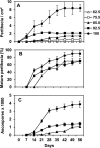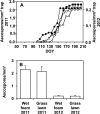Effects of Temperature and Moisture on Development of Fusarium graminearum Perithecia in Maize Stalk Residues
- PMID: 26475114
- PMCID: PMC4702647
- DOI: 10.1128/AEM.02436-15
Effects of Temperature and Moisture on Development of Fusarium graminearum Perithecia in Maize Stalk Residues
Abstract
Fusarium graminearum is the predominant component of the Fusarium head blight complex of wheat. F. graminearum ascospores, which initiate head infection, mature in perithecia on crop residues and become airborne. The effects of temperature (T) and moisture on perithecium production and maturation and on ascospore production on maize stalk residues were determined. In the laboratory, perithecia were produced at temperatures between 5 and 30°C (the optimum was 21.7°C) but matured only at 20 and 25°C. Perithecia were produced when relative humidity (RH) was ≥75% but matured only when RH was ≥85%; perithecium production and maturation increased with RH. Equations describing perithecium production and maturation over time as a function of T and RH (R(2) > 0.96) were developed. Maize stalks were also placed outdoors on three substrates: a grass lawn exposed to rain; a constantly wet, spongelike foam exposed to rain; and a grass lawn protected from rain. No perithecia were produced on stalks protected from rain. Perithecium production and maturation were significantly higher on the constantly wet foam than on the intermittently wet lawn (both exposed to rain). Ascospore numbers but not their dispersal patterns were also affected by the substrate.
Copyright © 2015, American Society for Microbiology. All Rights Reserved.
Figures






References
-
- Gilbert J, Haber S. 2013. Overview of some recent research developments in Fusarium head blight of wheat. Can J Plant Pathol 35:149–174. doi:10.1080/07060661.2013.772921. - DOI
-
- Parry DW, Jenkinson P, Mcleod L. 1995. Fusarium ear blight (scab) in small grain cereals—a review. Plant Pathol 44:207–238. doi:10.1111/j.1365-3059.1995.tb02773.x. - DOI
-
- Bai G, Shaner G. 1994. Scab of wheat: prospects for control. Plant Dis 78:760–766. doi:10.1094/PD-78-0760. - DOI
MeSH terms
Substances
LinkOut - more resources
Full Text Sources

